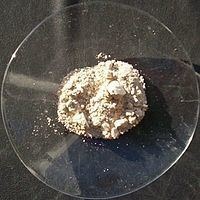Formula CuI Melting point 606 °C Boiling point 1,290 °C | Molar mass 190.45 g/mol Density 5.67 g/cm³ | |
 | ||
Appearance White powderwhen impure tan or brownish | ||
Copper(I) iodide is the inorganic compound with the formula CuI. It is also known as cuprous iodide. It is useful in a variety of applications ranging from organic synthesis to cloud seeding.
Contents
Pure copper(I) iodide is white, but samples are often tan or even, when found in nature as rare mineral marshite, reddish brown, but such color is due to the presence of impurities. It is common for samples of iodide-containing compounds to become discolored due to the facile aerobic oxidation of the iodide anion to molecular iodine.
Structure
Copper(I) iodide, like most "binary" (containing only two elements) metal halides, is an inorganic polymer. It has a rich phase diagram, meaning that it exists in several crystalline forms. It adopts a zinc blende structure below 390 °C (γ-CuI), a wurtzite structure between 390 and 440 °C (β-CuI), and a rock salt structure above 440 °C (α-CuI). The ions are tetrahedrally coordinated when in the zinc blende or the wurtzite structure, with a Cu-I distance of 2.338 Å. Copper(I) bromide and copper(I) chloride also transform from the zinc blende structure to the wurtzite structure at 405 and 435 °C, respectively. Therefore, the longer the copper – halide bond length, the lower the temperature needs to be to change the structure from the zinc blende structure to the wurtzite structure. The interatomic distances in copper(I) bromide and copper(I) chloride are 2.173 and 2.051 Å, respectively.
Preparation
Copper(I) iodide can be prepared by heating iodine and copper in concentrated hydriodic acid, HI. In the laboratory however, copper(I) iodide is prepared by simply mixing an aqueous solution of sodium or potassium iodide and a soluble copper(II) salt such copper sulfate.
Cu2+ + 2I− → CuI2The CuI2 immediately decomposes to iodine and insoluble copper(I) iodide, releasing I2.
2 CuI2 → 2 CuI + I2This reaction has been employed as a means of assaying copper(II) samples, since the evolved I2 can be analyzed by redox titration. The reaction in itself may look rather odd, as using the rule of thumb for a proceeding redox reaction, Eooxidator − Eoreductor > 0, this reaction fails. The quantity is below zero, so the reaction should not proceed. But the equilibrium constant for the reaction is 1.38*10−13. By using fairly moderate concentrates of 0.1 mol/L for both iodide and Cu2+, the concentration of Cu+ is calculated as 3*10−7. As a consequence, the product of the concentrations is far in excess of the solubility product, so copper(I)iodide precipitates. The process of precipitation lowers the copper(I) concentration, providing an entropic driving force according to Le Chatelier's principle, and allowing the redox reaction to proceed.
CuI is poorly soluble in water (0.00042 g/L at 25 °C), but it dissolves in the presence of NaI or KI to give the linear anion [CuI2]−. Dilution of such solutions with water reprecipitates CuI. This dissolution–precipitation process is employed to purify CuI, affording colorless samples.
Uses
CuI has several uses:
